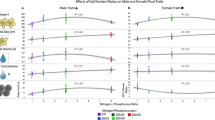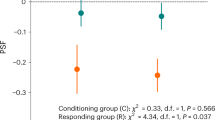Abstract
Edaphic factors can lead to differences in plant morphology and tissue chemistry. However, whether these differences result in altered plant–insect interactions for soil-generalist plants is less understood. We present evidence that soil chemistry can alter plant–insect interactions both directly, through chemical composition of plant tissue, and indirectly, through plant morphology, for serpentine-tolerant Mimulus guttatus (Phrymaceae). First, we scored floral display (corolla width, number of open flowers per inflorescence, and inflorescence height), flower chemistry, pollinator visitation and florivory of M. guttatus growing on natural serpentine and non-serpentine soil over 2 years. Second, we conducted a common garden reciprocal soil transplant experiment to isolate the effect of serpentine soil on floral display traits and flower chemistry. And last, we observed arrays of field-collected inflorescences and potted plants to determine the effect of soil environment in the field on pollinator visitation and florivore damage, respectively. For both natural and experimental plants, serpentine soil caused reductions in floral display and directly altered flower tissue chemistry. Plants in natural serpentine populations received fewer pollinator visits and less damage by florivores relative to non-serpentine plants. In experimental arrays, soil environment did not influence pollinator visitation (though larger flowers were visited more frequently), but did alter florivore damage, with serpentine-grown plants receiving less damage. Our results demonstrate that the soil environment can directly and indirectly affect plant–mutualist and plant–antagonist interactions of serpentine-tolerant plants by altering flower chemistry and floral display.





Similar content being viewed by others
References
Alonso C (1999) Variation in herbivory by Yponomeuta mahalebella on its only host plant Prunus mahaleb along an elevational gradient. Ecol Entomol 24:371–379
Alonso C, Herrera CM (2003) Developmental and spatial covariation of nutrients in growing leaves of Daphne laureola and their relationships with herbivory. New Phytol 159:645–656
Antonovics J, Bradshaw AD, Turner RG (1971) Heavy metal tolerance in plants. Adv Ecol Res 7:1–85
Ashman T-L, Penet L (2007) Direct and indirect effects of a sex-based antagonist on male and female fertility: consequences for reproductive and trait evolution in a gender-dimorphic plant. Am Nat 169:595–608
Asikainen E, Mutikainen P (2005) Pollen and resource limitation in a gynodioecious species. Am J Bot 92:487–494
Baker AJM, Brooks RR (1989) Terrestrial higher plants which hyperaccumulate metallic elements—a review of their distribution, ecology and phytochemistry. Biorecovery 1:81–126
Beanland L, Phelan PL, Salminen S (2003) Micronutrient interactions on soybean growth and the developmental performance of three insect herbivores. Environ Entomol 32:641–651
Bernhardt CE, Mitchell RJ, Michaelst HJ (2008) Pollinator behavior, and pollen tube abundance in Lupinus perennis. Int J Plant Sci 169:944–953
Botto-Mahan C, Ramirez PA, Ossa CG, Medel R, Ojeda-Camacho M, Gonzalez AV (2011) Floral herbivory affects female reproductive success and pollinator visitation in the perennial herb Alstroemeria ligtu (Alstromeriaceae). Int J Plant Sci 172:1130–1136
Boyd RS, Moar WJ (1999) The defensive function of Ni in plants: response of the polyphagous herbivore Spodoptera exigua (Lepidoptera: Noctuidae) to hyperaccumulator and accumulator species of Streptanthus (Brassicaceae). Oecologia 118:218–224
Boyd RS, Shaw J, Martens SN (1994) Nickel hyperaccumulation defends Streptanthus polygaloides (Brassicaceae) against pathogens. Am J Bot 81:294–300
Brady KU, Kruckeberg AR, Bradshaw HD Jr (2005) Evolutionary ecology of plant adaptation to serpentine soils. Annu Rev Ecol Evol Syst 36:243–266
Breitburg DL, Loher T, Pacey CA, Gerstein A (1997) Varying effects of low dissolved oxygen on trophic interactions in an estuarine food web. Ecol Monogr 67:489–507
Burnett SE, Zhang DL, Stack LB, He ZQ (2008) Effects of phosphorus on morphology and foliar nutrient concentrations of hydroponically grown Scaevola aemula R. Br. ‘Whirlwind Blue’. HortScience 43:902–905
Chalcraft DR, Andrews RM (1999) Predation on lizard eggs by ants: species interactions in a variable physical environment. Oecologia 119:285–292
Coleman CM, Boyd RS, Eubanks MD (2005) Extending the elemental defense hypothesis: dietary metal concentrations below hyperaccumulator levels could harm herbivores. J Chem Ecol 31:1669–1681
Connell JH (1961) Effects of competition, predation by Thais lapillus, and other factors on natural populations of the barnacle Balanus balanoides. Ecol Monogr 31:61–104
Cunningham SA, Summerhayes B, Westoby M (1999) Evolutionary divergences in leaf structure and chemistry, comparing rainfall and soil nutrient gradients. Ecology 69:569–588
Davoodian N, Bosworth J, Rajakaruna N (2012) Mycorrhizal colonization of Hypericum perforatum L. (Hypericaceae) from serpentine and granite outcrops on the Deer Isles, Maine. Northeast Nat 19:517–526
Duffy KJ, Stout JC (2011) Effects of conspecific and heterospecific floral density on the pollination of two related rewarding orchids. Plant Ecol 212:1397–1406
Esslemont G, Maher W, Ford P (2000) The determination of phosphorous and other elements in plant leaves by ICP-MS after low-volume microwave digestion with nitric acid. At Spectrosc 21:42–45
Fordyce JA (2006) The evolutionary consequences of ecological interactions mediated through phenotypic plasticity. J Exp Biol 209:2377–2383
Galen C (2000) High and dry: drought stress, sex-allocation trade-offs, and selection on flower size in the alpine wildflower Polemonium viscosum. Am Nat 156:72–83
Gardner M, Macnair M (2000) Factors affecting the co-existence of the serpentine endemic Mimulus nudatus Curran and its presumed progenitor, Mimulus guttatus Fischer ex DC. Biol J Linn Soc Lond 69:443–459
Ghazoul J (2005) Pollen and seed dispersal among dispersed plants. Biol Rev 80:413–443
Hargreaves AL, Harder LD, Johnson SD (2009) Consumptive emasculation: the ecological and evolutionary consequences of pollen theft. Biol Rev 84:259–276
Harrison S, Rajakaruna N (2011) Serpentine: the evolution and ecology of a model system. University of California Press, London
Held D, Potter D (2004) Floral affinity and benefits of dietary mixing with flowers for a polyphagous scarab, Popillia japonica Newman. Oecologia 140:312–320
Hladun KR, Perker DR, Trumble JT (2011) Selenium accumulation in the floral tissues of two Brassicaceae species and its impact on floral traits and plant performance. Environ Exp Bot 74:90–97
Hladun KR, Parker DR, Tran KD, Trumble JT (2013) Effects of selenium accumulation on phytotoxicity, herbivory, and pollination ecology in radish (Raphanus sativus L.). Environ Pollut 172:70–75
Ivey CT, Carr DE (2005) Effects of herbivory and inbreeding on the pollinators and mating system of Mimulus guttatus (Phrymaceae). Am J Bot 92:1641–1649
Joern A, Provin T, Behmer ST (2012) Not just the usual suspects: insect herbivore populations and communities are associated with multiple plant nutrients. Ecology 93:1002–1015
Juenger T, Morton TC, Miller RE, Bergleson J (2005) Scarlet gilia resistance to insect herbivory: the effects of early season flowering, plant appearance, and phytochemistry on patterns of seed fly attack. Evol Ecol 19:79–101
Klanderud K, Totland O (2005) Simulated climate change altered dominance hierarchies and diversity of an alpine biodiversity hotspot. Ecology 86:2047–2054
Knight TM, Steets JA, Vamosi JC, Mazer SJ, Burd M, Campbell DR, Dudash MR, Johnston MO, Mitchell RJ, Ashman T-L (2005) Pollen limitation of plant reproduction: pattern and process. Annu Rev Ecol Evol Syst 36:467–497
Lau JA, McCall A, Davies K, McKay JK, Wright J (2008) Herbivores and edaphic factors constrain the realized niche of a native plant. Ecology 89:754–762
Marschner H (1986) Mineral nutrition of higher plants. Academic, Orlando
Martens SN, Boyd RS (1994) The ecological significance of nickel hyperaccumulation: a plant chemical defense. Oecologia 98:379–384
McCall AC, Irwin RE (2006) Florivory: the intersection of pollination and herbivory. Ecol Lett 9:1351–1365
Meindl GA, Ashman T-L (2013) The effects of aluminum and nickel in nectar on the foraging behavior of bumblebees. Environ Pollut 177:78–81
Mitchell RJ, Karron JD, Holmquist KG, Bell JM (2004) The influence of Mimulus ringens floral display size on pollinator visitation patterns. Funct Ecol 18:116–124
Mithöfer A, Boland A (2012) Plant defense against herbivores: chemical aspects. Annu Rev Plant Biol 63:431–450
Mothershead K, Marquis RJ (2000) Fitness impacts of herbivory through indirect effects on plant–pollinator interactions in Oenothera macrocarpa. Ecology 81:30–40
Murren CJ, Douglass L, Gibson A, Dudash MR (2006) Individual and combined effects of Ca/Mg ratio and water on trait expression in Mimulus guttatus. Ecology 87:2591–2602
Nagy L, Proctor J (1997) Plant growth and reproduction on a toxic alpine ultramafic soil: adaptation to nutrient limitation. New Phytol 137:267–274
Oze C, Skinner C, Schroth AW, Coleman RG (2008) Growing up green on serpentine soils: biogeochemistry of serpentine vegetation in the Central Coast Range of California. Appl Geochem 23:3391–3403
Park T (1954) Experimental studies of interspecies competition II. Temperature, humidity, and competition in two species of Tribolium. Physiol Zool 27:177–238
Perkins MC, Woods HA, Harrison JF, Elser JJ (2004) Dietary phosphorus affects the growth of larval Manduca sexta. Arch Insect Biochem Physiol 55:153–168
Pilon-Smits EAH, Quinn CF, Tapken W, Malagoli M, Schiavon M (2009) Physiological functions of beneficial elements. Curr Opin Plant Biol 12:267–274
Pugnaire FI, Luque MT (2001) Changes in plant interactions along a gradient of environmental stress. Oikos 93:42–49
Quinn CF, Prins CN, Freeman JL, Gross AM, Hantzis LJ, Reynolds RJB, Yang SI, Covey PA, Banuelos GS, Pickering IJ, Fakra SC, Marcus MA, Arathi HS, Pilon-Smits EAH (2011) Selenium accumulation in flowers and its effects on pollination. New Phytol 192:727–737
Robertson AW, Diaz A, Macnair MR (1994) The quantitative genetics of floral characters in Mimulus guttatus. Heredity 72:300–311
Robertson AW, Mountjoy C, Faulkner BE, Roberts MV, Macnair MR (1999) Bumble bee selection of Mimulus guttatus flowers: the effects of pollen quality and reward depletion. Ecology 80:2594–2606
Safford HD, Viers JH, Harrison SP (2005) Serpentine endemism in the California flora: a database of serpentine affinity. Madroño 52:222–257
Saikkonen K, Koivunen S, Vuorisalo T, Mutikainen P (1998) Interactive effects of pollination and heavy metals on resource allocation in Potentilla anserina L. Ecology 79:1620–1629
Sambatti JB, Rice KJ (2006) Local adaptation, patterns of selection, and gene flow in the Californian serpentine sunflower. Evolution 60:696–710
Schechter SP, Bruns TD (2008) Serpentine and non-serpentine ecotypes of Collinsia sparsiflora associate with distinct arbuscular mycorrhizal fungal assemblages. Mol Ecol 17:3198–3210
Strauss SY, Agrawal AA (1999) The ecology and evolution of plant tolerance to herbivory. Trends Ecol Evol 14:179–185
Thompson JN (1999) Specific hypotheses on the geographic mosaic of coevolution. Am Nat 153:1–14
Vickery RK (1978) Case studies in the evolution of species complexes in Mimulus. Evol Biol 11:405–507
Wang HG, Mopper S (2008) Separate and interacting effects of deer florivory and salinity stress on herbivores. Oikos 117:564–570
Westerbergh A, Saura A (1994) Gene flow and pollinator behavior in Silene dioica populations. Oikos 71:215–224
Wolfe LM (2002) Why alien invaders succeed: support for the escape-from-enemy hypothesis. Am Nat 160:705–711
Wright JW, Stanton ML, Scherson R (2006) Local adaptation to serpentine and non-serpentine soils in Collinsia sparsiflora. Evol Ecol Res 8:1–21
Zangerl AR, Rutledge CE (1996) The probability of attack and patterns of constitutive and induced defense: a test of optimal defense theory. Am Nat 147:599–608
Acknowledgments
We thank P. Aigner, C. Koehler and R. Woerly of the McLaughlin Natural Reserve and G. Arceo-Goméz, M. H. Koski and C. Alonso for providing assistance at field sites. K. DeHart assisted with plant tissue element analysis. J. Pitts, J. Wenzel and J. Rawlins assisted with insect identification. This manuscript was improved by comments from C. Caruso and two anonymous reviewers. This research was funded by grants from the PA Academy of Science, CA Native Plant Society, Botanical Society of America, and Sigma Xi to G.A.M., NSF (EAR-IF 0948366) to D.J.B., and NSF (DEB 1020523) to T.L.A. The experiments performed comply with the current laws of the United States of America.
Author information
Authors and Affiliations
Corresponding author
Additional information
Communicated by Christina Caruso.
Electronic supplementary material
Below is the link to the electronic supplementary material.
Rights and permissions
About this article
Cite this article
Meindl, G.A., Bain, D.J. & Ashman, TL. Edaphic factors and plant–insect interactions: direct and indirect effects of serpentine soil on florivores and pollinators. Oecologia 173, 1355–1366 (2013). https://doi.org/10.1007/s00442-013-2711-y
Received:
Accepted:
Published:
Issue Date:
DOI: https://doi.org/10.1007/s00442-013-2711-y




